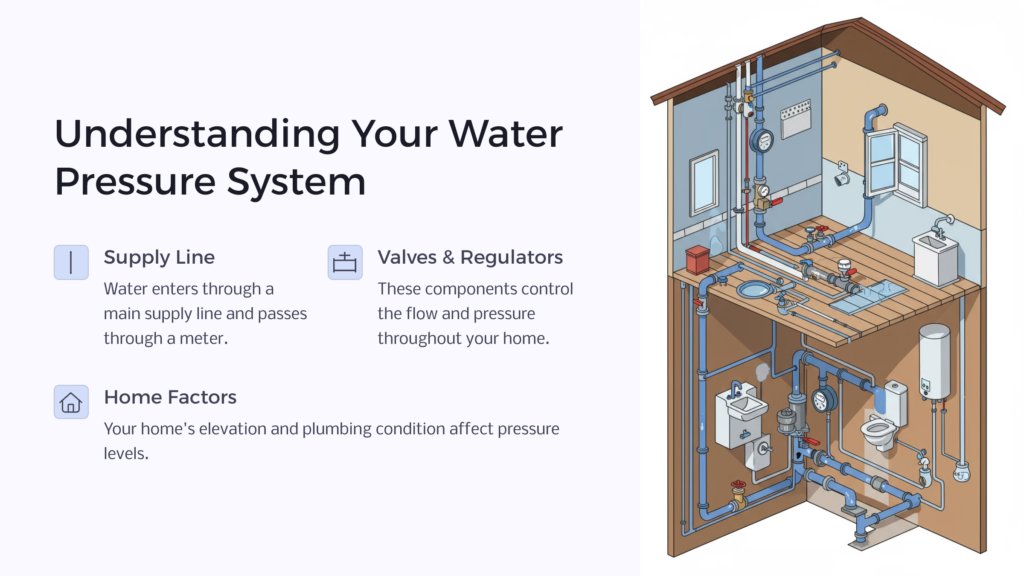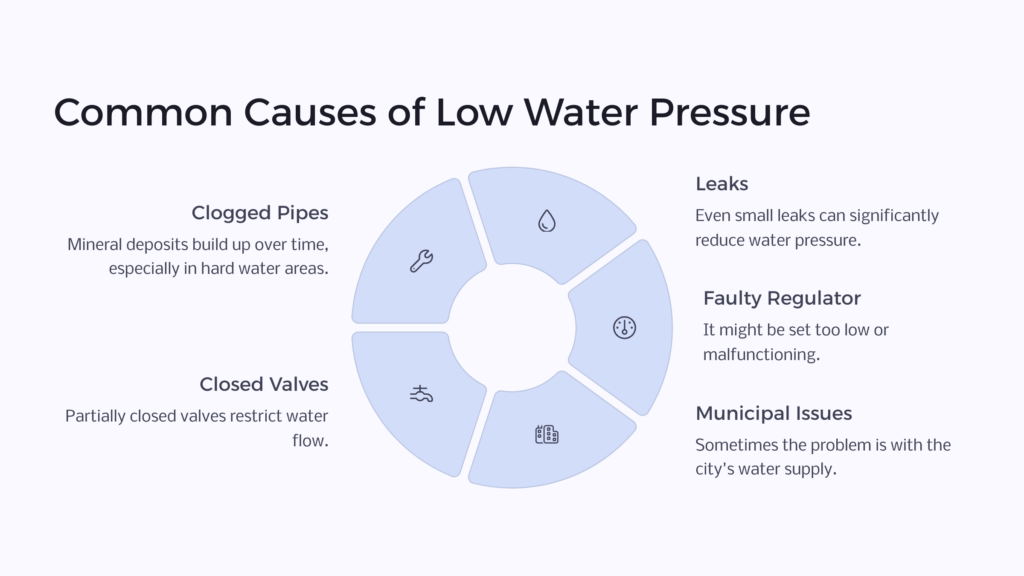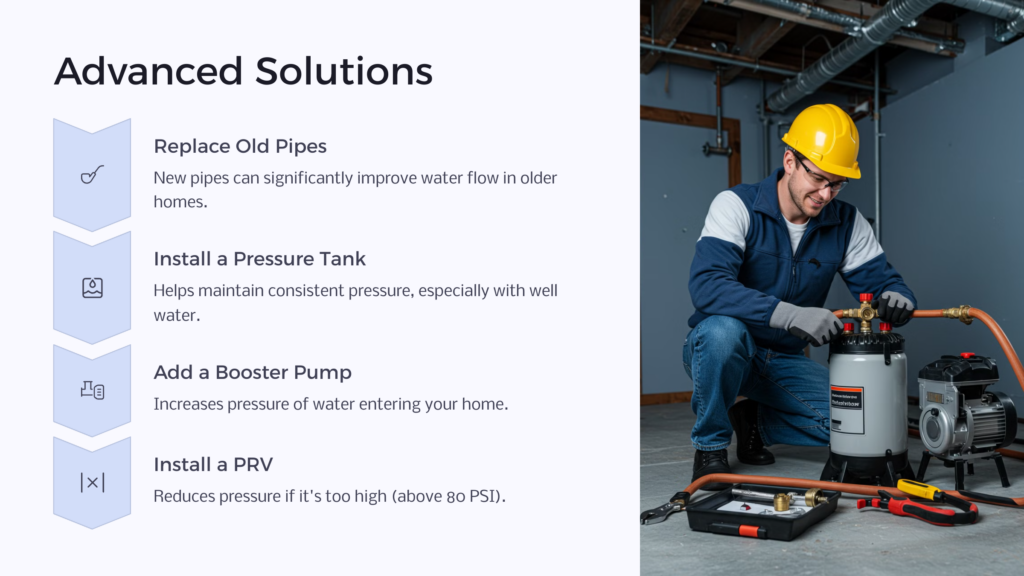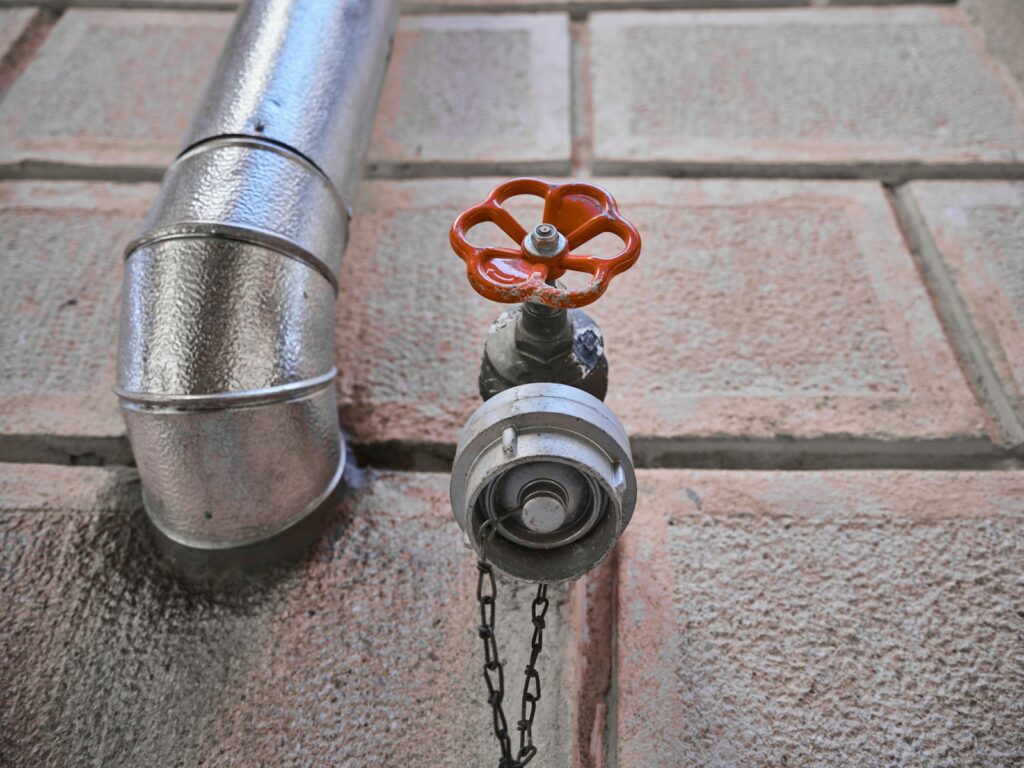Water pressure is a crucial part of your home’s plumbing system. It’s what makes water flow through your pipes and out of your faucets, showerheads, and appliances. When you turn on a tap, the pressure pushes the water through the pipes and out into your sink or shower. This pressure is measured in pounds per square inch (PSI).

In most homes, good water pressure ranges from 40 to 60 PSI. Anything below 40 PSI is considered low, while pressure above 80 PSI can damage your pipes and appliances. Your home’s water pressure depends on several factors, including the elevation of your house, the municipal water supply pressure, and the condition of your plumbing system.
Understanding how your home’s water pressure system works is the first step in figuring out how to improve it. Whether you’re on city water or have a well, the principles are similar. Water enters your home through a main supply line, passes through a water meter, and then flows into your home’s pipes. Along the way, various valves and regulators can affect the pressure.
Common Causes of Low Water Pressure
Low water pressure can be frustrating, turning simple tasks like showering or washing dishes into time-consuming chores. There are several reasons why you might be experiencing low water pressure in your home:

1. Clogged pipes: Over time, mineral deposits can build up in your pipes, reducing water flow. This is especially common in areas with hard water.
2. Leaks: Even small leaks in your plumbing system can significantly reduce water pressure. These leaks might be hidden behind walls or under floors.
3. Faulty pressure regulator: If your home has a pressure regulator, it might be set too low or could be malfunctioning.
4. Municipal supply issues: Sometimes, the problem isn’t in your home at all but with the city’s water supply.
5. Partially closed valves: The main water valve or individual fixture valves might not be fully open, restricting water flow.
Identifying the cause of your low water pressure is crucial for finding the right solution. In some cases, you might be able to fix the issue yourself, while others may require professional help.
How to Test Your Water Pressure
Before you can improve your water pressure, you need to know exactly what you’re dealing with. Testing your water pressure is a simple process that you can do yourself with the right tools. Here’s how to test your water pressure:
1. Purchase a water pressure gauge from your local hardware store or online. These are inexpensive and easy to use.
2. Attach the gauge to an outdoor faucet or hose bib. Make sure no other water sources in your home are running when you do this test.
3. Turn on the faucet fully and read the pressure on the gauge. Remember, ideal pressure is between 40 and 60 PSI.
If your pressure reads below 40 PSI, you likely have a low water pressure issue that needs addressing. If it’s above 80 PSI, you might need to reduce your water pressure to prevent damage to your plumbing system.
Testing your water pressure at different times of the day can also be helpful. If you notice significant fluctuations, it could indicate a problem with the municipal water supply or your home’s plumbing system.
Quick Fixes to Improve Water Pressure
If you’ve confirmed that your water pressure is low, there are several quick fixes you can try before calling in a professional:
1. Check your fixtures: Sometimes, low water pressure is isolated to a single fixture. Remove and clean faucet aerators and showerheads, which can become clogged with mineral deposits over time.
2. Inspect for leaks: Look for visible leaks around faucets, toilets, and exposed pipes. Even small leaks can affect your water pressure.
3. Open valves fully: Locate your main water valve (usually near where the water line enters your home) and make sure it’s fully open. Also check individual shut-off valves under sinks and behind toilets.
4. Check your pressure regulator: If your home has a pressure regulator, it might need adjustment. This is typically a bell-shaped device located where the main water line enters your home.
These simple steps can often resolve minor water pressure issues. However, if you’ve tried these fixes and still have low pressure, you may need to explore more advanced solutions or seek professional help.
Addressing Clogged Fixtures and Pipes
Clogged fixtures and pipes are common culprits behind low water pressure. Over time, mineral deposits, especially in areas with hard water, can build up inside pipes and fixtures, restricting water flow. Here’s how to address this issue:
For fixtures like faucets and showerheads, start by removing them and soaking them in vinegar overnight. This natural acid can dissolve mineral buildup effectively. After soaking, scrub the fixtures gently with an old toothbrush to remove any remaining deposits. Rinse thoroughly before reattaching.
If you suspect your pipes are clogged, the solution might be more involved. You can try flushing your pipes with a mixture of hot water and vinegar, but be cautious as this may not be suitable for all types of plumbing. For more severe clogs, you might need to use a plumbing snake or call a professional plumber to clean out your pipes.
Remember, preventing clogs is easier than treating them. Consider installing a water softener if you live in an area with hard water. This can help reduce mineral buildup in your pipes and fixtures over time.
Adjusting the Main Water Valve
Sometimes, low water pressure can be as simple as a partially closed main water valve. This valve controls the flow of water into your home and is typically located near your water meter or where the main water line enters your house. Here’s how to check and adjust it:
1. Locate your main water valve. It’s often in the basement, crawl space, or near an outside wall.
2. Check if the valve is fully open. For gate valves (which look like a wheel), turn counterclockwise until it stops. For ball valves (which have a lever handle), the handle should be parallel to the pipe when fully open.
3. If the valve wasn’t fully open, opening it completely may immediately improve your water pressure.
Be careful when adjusting the main water valve. If it’s old or hasn’t been turned in a while, it might be stiff or even break. If you’re unsure or uncomfortable doing this yourself, it’s best to call a plumber.
Advanced Solutions for Persistent Issues

If you’ve tried the quick fixes and are still experiencing low water pressure, it might be time to consider more advanced solutions. These typically require more expertise and, in some cases, professional installation:
1. Replace old pipes: If you live in an older home, your pipes might be corroded or narrowed due to years of mineral buildup. Replacing old pipes with new ones can significantly improve water pressure.
2. Install a pressure tank: For homes with well water, a pressure tank can help maintain consistent water pressure throughout the house.
3. Use a water pressure booster pump: This device can increase the pressure of water coming into your home. It’s particularly useful if your municipal water supply provides low pressure.
4. Address issues with your well: If you’re on well water, low pressure could indicate problems with your well pump or water table levels.
These solutions often require significant investment and expertise. It’s usually best to consult with a professional plumber before proceeding with any of these options to ensure they’re appropriate for your specific situation.
Installing a Pressure-Reducing Valve
While this article focuses on increasing water pressure, sometimes the issue is actually too much pressure. High water pressure can damage pipes and appliances over time. If your water pressure test shows readings consistently above 80 PSI, you might need to install a pressure-reducing valve (PRV).
A PRV is typically installed where the main water line enters your home. It reduces the pressure of water coming from the municipal supply to a more manageable level for your home’s plumbing system. Here’s a basic overview of the installation process:
1. Shut off the main water supply to your home.
2. Cut the main water line where you want to install the PRV.
3. Install the PRV, ensuring the flow arrow points in the direction of water flow.
4. Use appropriate fittings to connect the PRV to your existing pipes.
5. Turn the water back on and adjust the PRV to the desired pressure.
While handy homeowners might be able to install a PRV themselves, it’s often best to hire a professional plumber for this job. Incorrect installation could lead to leaks or other plumbing issues.
Using a Water Pressure Booster Pump
If your home consistently suffers from low water pressure, a water pressure booster pump might be the solution. This device increases the pressure of water as it enters your home, ensuring strong water flow throughout your plumbing system.
A booster pump works by pulling water from your main supply line into a pressure tank. The pump then pushes the water out of the tank and into your home’s pipes at a higher pressure. This can be especially useful for homes at the end of a municipal water line or those in areas with naturally low water pressure.
Installing a booster pump is a complex job that usually requires professional help. The process typically involves:
1. Choosing an appropriate location for the pump, usually near where the main water line enters your home.
2. Installing a bypass valve to allow for pump maintenance without shutting off your home’s water supply.
3. Connecting the pump to your home’s electrical system.
4. Adjusting the pump settings to achieve the desired water pressure.
While a booster pump can significantly improve your water pressure, it’s important to note that it will increase your energy consumption. Consider this ongoing cost when deciding if a booster pump is right for your home.
When to Call a Professional Plumber
While many water pressure issues can be resolved with DIY solutions, there are times when it’s best to call in a professional plumber. Here are some situations where professional help is recommended:
1. If you’ve tried multiple DIY solutions and still have low water pressure.
2. If you suspect a major leak in your plumbing system, especially one that’s not visible.
3. When installing complex equipment like pressure-reducing valves or booster pumps.
4. If you’re dealing with issues related to your well system.
5. When you need to replace old or damaged pipes.
Professional plumbers have the tools, knowledge, and experience to diagnose and fix complex water pressure issues. They can also ensure that any repairs or installations are done correctly and up to local code requirements.
When choosing a plumber, look for licensed and insured professionals with good reviews. Get multiple quotes if possible, and don’t hesitate to ask questions about their proposed solutions.
Maintenance Tips for Optimal Water Pressure

Maintaining good water pressure isn’t just about fixing problems as they arise. Regular maintenance can help prevent issues and keep your water flowing smoothly. Here are some tips to maintain optimal water pressure:
1. Regular cleaning: Clean faucet aerators and showerheads every few months to prevent mineral buildup.
2. Check for leaks: Routinely inspect visible pipes and fixtures for signs of leaks.
3. Test your pressure: Use a pressure gauge to check your water pressure annually. This can help you catch issues early.
4. Maintain your water heater: Flush your water heater annually to remove sediment that can affect water flow.
5. Consider water treatment: If you have hard water, installing a water softener can help prevent mineral buildup in your pipes and fixtures.
6. Be proactive: Address minor issues promptly before they become major problems.
By following these maintenance tips, you can help ensure consistent water pressure throughout your home and potentially avoid costly repairs down the line.
FAQs About Increasing Water Pressure
Q: Can low water pressure be dangerous?
A: While low water pressure itself isn’t dangerous, it can sometimes indicate larger problems like leaks, which could lead to water damage or mold growth if left unchecked.
Q: How much does it cost to install a water pressure booster pump?
A: The cost can vary widely depending on your location and specific needs, but typically ranges from $300 to $2,000, including installation.
Q: Will increasing my water pressure increase my water bill?
A: It might. Higher pressure means more water flows through your pipes when you turn on a faucet. However, tasks might be completed faster (like filling a bathtub), potentially balancing out the increase.
Q: Can I increase water pressure in just one area of my home?
A: Yes, if the low pressure is isolated to one fixture or area. This might involve cleaning or replacing the affected fixtures or addressing local pipe issues.
Q: How often should I check my home’s water pressure?
A: It’s a good idea to check your water pressure annually, or any time you notice a change in water flow.
Remember, while many water pressure issues can be resolved with DIY solutions, don’t hesitate to call a professional if you’re unsure or if the problem persists. Proper water pressure not only improves your daily life but also helps maintain the health of your plumbing system.
